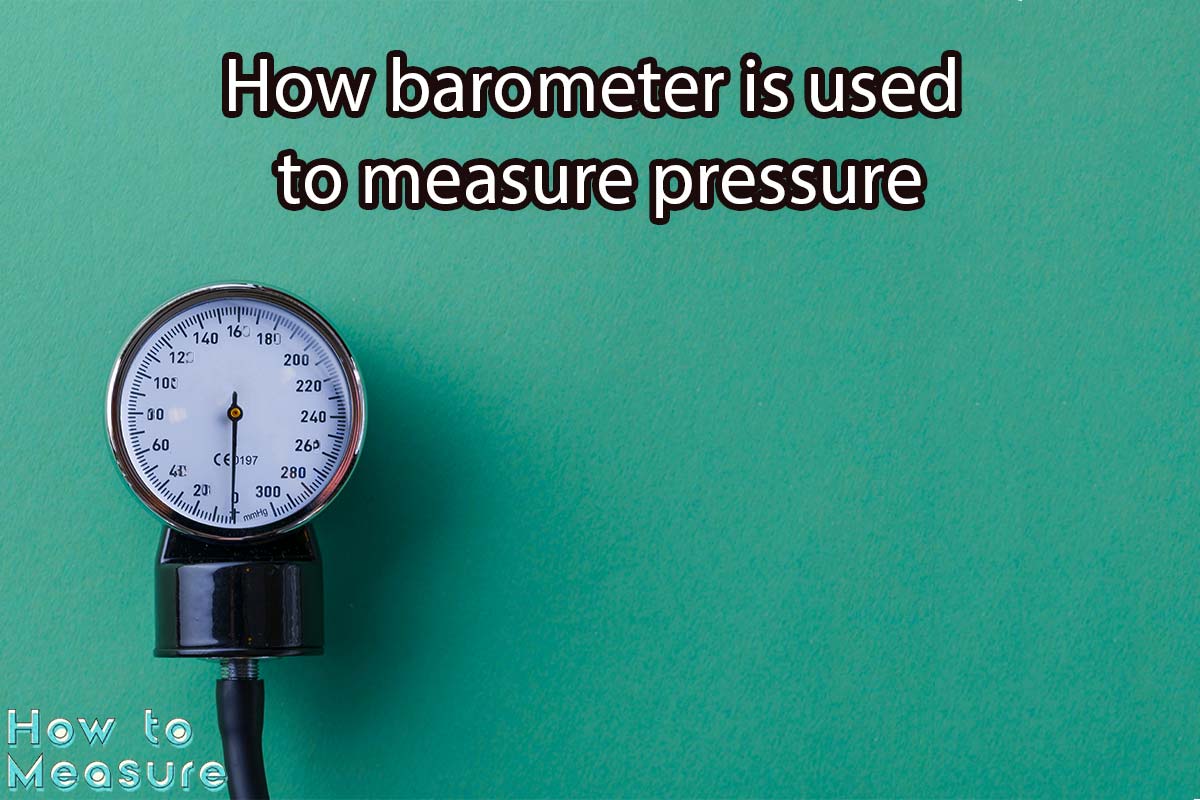A barometer is an instrument used to measure atmospheric pressure. This measurement is essential for various fields, including meteorology, aviation, and marine navigation. In the past, barometers were used to forecast the weather, and while they are less commonly used for this purpose today, they still play a crucial role in measuring air pressure and its changes. In this article, we will delve into the history of the barometer, its different types, and how it is used to measure pressure. We will also examine the importance of atmospheric pressure in various industries and how barometers have evolved over time to meet the demands of modern applications.In the essay we in How to measure will talk more about this topic.
Introduction to Barometers: A Brief History
A barometer is an instrument used to measure atmospheric pressure, and its history can be traced back to the 17th century. Evangelista Torricelli invented the first barometer in 1643. An Italian physicist and mathematician, Torricelli, filled a long glass tube with mercury and inverted it into a dish of the same metal. He observed that the height of the mercury in the line varied with changes in atmospheric pressure. This simple yet brilliant experiment created the first barometer and marked the beginning of a new era in measuring air pressure.

Over the centuries, barometers have undergone numerous improvements and modifications to meet the demands of various applications. Today, barometers come in many shapes and sizes and are used in multiple fields, including meteorology, aviation, and marine navigation. Despite these advances, the basic principle behind the barometer remains the same: it measures atmospheric pressure by using a column of fluid in a sealed container.
Understanding Atmospheric Pressure
Atmospheric pressure, also known as air pressure, is the force exerted by the weight of the Earth’s atmosphere on the surface. It is a result of the collision of atmospheric molecules with the Earth’s surface and is expressed in units of force per unit area, such as pounds per square inch (psi) or hectopascals (hPa).
Atmospheric pressure is not constant and varies with altitude, temperature, and weather conditions. For example, as you ascend elevation, the atmospheric pressure decreases due to the lower air density at higher altitudes. Similarly, low-pressure systems associated with storms and fronts are characterized by lower atmospheric pressure compared to high-pressure plans, which are associated with clear, calm weather.
Understanding atmospheric pressure is important for a variety of applications, including weather forecasting, aviation, and marine navigation. We can gain insight into current weather conditions and predict future weather patterns by measuring atmospheric pressure. In aviation, barometers are used to determine altitude, while in marine navigation, they help sailors navigate through changes in air pressure associated with weather systems.
In conclusion, atmospheric pressure is a crucial aspect of our environment that affects our daily lives in many ways. Understanding it and measuring it accurately is essential for various industries and applications.
Different Types of Barometers and Their Uses
There are several barometers, each with its unique design and purpose. Some of the most common types of barometers include:
- Mercury Barometer: The first barometer invented by Torricelli was a mercury barometer. It consists of a long glass tube filled with mercury and inverted into a dish of the same metal. The height of the mercury in the line varies with changes in atmospheric pressure, We are providing an accurate measurement of air pressure.
- Aneroid Barometer: An aneroid barometer uses a small, flexible metal container known as an aneroid cell that expands or contracts with changes in atmospheric pressure. The movement of the cell is transferred to a dial via a mechanical linkage, which indicates the current atmospheric pressure. Aneroid barometers are commonly used in Portable weather instruments and aircraft altimeters.
- Digital Barometer: A digital barometer uses electronic sensors to measure atmospheric pressure. The pressure readings are displayed on a digital display and can be quickly recorded and analyzed. Digital barometers are famous for their accuracy, ease of use, and Portability.
- Fortin Barometer: A Fortin barometer is a type of the aneroid barometer that is used to measure pressure in the deep ocean. Unlike other types of barometers, which limited by the force of the air, Fortin barometers can measure pressure at depths of up to several kilometers.
- Barographs: Barographs are specialized barometers that record changes in atmospheric pressure over time. They are commonly used in meteorology and aviation to monitor pressure trends and detect weather. Patterns.
In conclusion, each type of the barometer has its strengths and weaknesses, and the best barometer for a the particular application depends on the specific requirements and conditions. Whether used for weather forecasting, aviation, or marine navigation, barometers play a crucial role in measuring atmospheric pressure and understanding the needs of our environment.
How Barometers Measure Pressure?
Barometers measure atmospheric pressure by using a fluid column in a sealed container. The basic principle behind all barometers is that the height of the liquid in the container is proportional to the atmospheric pressure. The size of the fluid can be used to calculate the atmospheric pressure, which is then expressed in units of force per unit area, such as pounds per square inch (psi) or hectopascals (hPa).
In a mercury barometer, the fluid column is mercury, and the height of the mercury in the tube is proportional to the atmospheric pressure. When the atmospheric pressure increases, the size of the mercury in the line also increases, and vice versa.
On the other hand, an aneroid barometer uses a small, flexible metal container known as an aneroid cell. The cell expands or contracts with changes in atmospheric pressure, and the movement of the cell is transferred to a dial via a mechanical linkage. The position of the dial indicates the current atmospheric pressure.
Digital barometers use electronic sensors to measure atmospheric pressure. The sensors convert the pressure readings into electrical signals, which are then processed by an electronic circuit and displayed on a digital display.
Regardless of the type of barometer, the basic principle behind each device remains the same: atmospheric pressure is measured by using a column of fluid in a sealed container. The height of the the liquid in the receptacle provides an accurate and direct measurement of atmospheric pressure, allowing us to gain valuable insights into the conditions of our environment.
The Importance of Barometers in Meteorology
Barometers are essential tools in meteorology, as they allow us to measure and monitor atmospheric pressure. This information is crucial for understanding and predicting weather patterns, as changes in atmospheric pressure closely tied to changes in weather conditions.
Meteorologists use barometers to measure the pressure of the air and the changes in pressure over time. Low-pressure systems are associated with storms and fronts and are characterized by lower atmospheric pressure than high-pressure systems, which are associated with clear, calm weather. By tracking changes in atmospheric pressure, meteorologists can make predictions about the movement and behavior of weather systems.
Barometers are also used in conjunction with other weather instruments, such as thermometers, hygrometers, and wind vanes, to gain a complete picture of the current weather conditions. This information is then used to make predictions about future weather patterns, allowing meteorologists to issue accurate weather forecasts.
In addition, barometers are used in aviation to determine altitude. Pilots can determine their height relative to sea level by measuring atmospheric pressure at different heights. This information is essential for safe flight, as changes in atmospheric pressure can affect the performance of aircraft and can impact visibility and flight conditions.

In conclusion, barometers play a crucial role in meteorology, providing essential information about atmospheric pressure and helping us to understand and predict weather patterns. Whether used in weather forecasting, aviation, or other industries, barometers are crucial tools for measuring the conditions of our environment and improving our understanding of the world around us.
The Role of Barometers in Aviation and Marine Navigation
Barometers play a crucial role in aviation and marine navigation, providing critical information about atmospheric pressure and altitude. In aviation, barometers determine the size, which is essential for safe flight. Pilots can determine their height relative to sea level by measuring atmospheric pressure at different heights. This information is used to ensure that aircraft stay at a safe altitude, maintain proper separation from other aircraft, and avoid obstacles.
In marine navigation, barometers are used to measure the pressure of the air, which can provide valuable information about the weather and sea conditions. Changes in atmospheric pressure can indicate the approach of storms or changes in wind direction, which can impact the safety of ships and their crews. By monitoring atmospheric pressure, mariners can make informed decisions about the best route to take and can take precautions to protect their vessels during rough weather conditions.
Barometers are also used in conjunction with other navigation instruments, such as compasses and GPS systems to ensure the safe and efficient operation of ships and aircraft. By providing accurate information about atmospheric pressure and altitude, barometers help to ensure the safety of both air and sea travelers.
In conclusion, barometers play a critical role in both aviation and marine navigation, providing essential information about atmospheric pressure and altitude. Whether used for flight planning or navigation at sea, barometers are crucial tools for ensuring the safety and efficiency of air and sea travel.
Barometer is used to Measure what and Where it is used?
A barometer is used to measure atmospheric pressure, providing valuable insights into the weight of the air column above a specific location. This measurement aids in understanding changes in weather patterns, predicting shifts in atmospheric conditions, and even assessing altitude variations. Whether for scientific purposes or practical applications, the barometer’s ability to gauge pressure is instrumental in unraveling the mysteries of our dynamic atmosphere.
Barometers are used to measure atmospheric pressure, which is the force exerted by the weight of the air in the Earth’s atmosphere. They can be used in various locations and settings to gauge atmospheric pressure changes. Some common places where barometers are used include:
-
Weather Stations: Professional weather stations use barometers to continuously monitor atmospheric pressure. This information is crucial for weather forecasting and understanding local weather patterns.
-
Airports and Aviation: Barometric pressure is essential for calibrating altimeters in aircraft. Pilots use accurate altitude measurements for safe takeoffs, landings, and navigation during flights.
-
Research Institutions: Barometers are used in research facilities and laboratories to study atmospheric pressure changes and their effects on different materials and systems.
-
Mountains and High-Altitude Areas: Climbers, hikers, and mountaineers carry portable barometers to estimate their altitude as they ascend or descend in high-altitude regions.
-
Oceanographic Research: Barometers are used in oceanography to monitor atmospheric pressure changes, which can influence ocean tides and currents.
-
Educational Settings: Barometers are used in classrooms to demonstrate concepts related to atmospheric pressure and its effects.
-
Personal Weather Stations: Many individuals set up personal weather stations at their homes to monitor local weather conditions, including atmospheric pressure changes.
-
Meteorological Agencies: Government and private meteorological agencies use barometers to gather data for weather forecasting and climate monitoring.
-
Seismic Monitoring: Barometric pressure changes can be linked to seismic activity, and barometers are used in seismological studies to monitor potential earthquake and volcanic activity.
-
Historical Sites and Museums: Antique barometers are often displayed in historical sites and museums as artifacts showcasing early methods of weather prediction.
-
Medical Facilities: In some cases, medical facilities may use barometric readings to monitor patients with conditions that are affected by changes in atmospheric pressure.
-
Scientific Experiments: Barometers might be used in scientific experiments that require precise pressure measurements, such as in material testing or controlled environments.
Overall, barometers have diverse applications and can be found in various settings where accurate measurements of atmospheric pressure are necessary for practical, scientific, or research purposes.
The Evolution of Barometers: From Traditional to Modern Applications
The barometer, a device used to measure atmospheric pressure has a long and fascinating history. The first barometers were invented in the 17th century and have since undergone significant evolution, with new designs and technologies emerging over the centuries.
The first barometers were simple devices, consisting of a sealed tube filled with liquid that was used to measure the weight of the air. These traditional barometers, known as mercury barometers were limited in their accuracy and sensitivity and were prone to damage from changes in temperature and pressure.
As technology improved, new designs were introduced that overcame the limitations of traditional barometers. The aneroid barometer, which uses a metal capsule instead of a liquid-filled tube, was developed in the 19th century and provided a more accurate and sensitive measurement of atmospheric pressure.
With the advent of electronics, barometer technology continued to evolve, leading to the development of digital barometers. These devices use microelectronic sensors to measure atmospheric pressure and convert the readings into digital signals. Digital barometers are now widely used in various applications, from weather forecasting to aviation and marine navigation.
In recent years, advances in microelectronics have led to the development of barometer sensors that are smaller, more accurate, and more energy-efficient. These sensors are now widely used in a variety of applications, including smartwatches, smartphones, and other portable devices.
In conclusion, the barometer has undergone significant evolution since its invention in the 17th century. From simple mercury barometers to modern digital devices, the barometer has played a critical role in our understanding of atmospheric pressure and weather patterns, and continues to be an essential tool in a wide range of applications.
Final Thoughts
In conclusion, barometers have proven to be an invaluable tool for measuring atmospheric pressure over the years. Barometers have evolved and improved from their early origins in the 17th century to their modern digital forms, becoming more accurate, sensitive, and efficient. Today, barometers are used in a variety of applications, including weather forecasting, aviation and marine navigation, and in portable devices such as smartwatches and smartphones.
The importance of barometers in measuring pressure cannot be overstated. They provide critical information about atmospheric pressure, allowing us to make informed decisions about flight and navigation and better understand the weather patterns that impact our daily lives. Barometers also play a critical role in ensuring our safety, providing essential information that helps pilots and mariners make informed decisions about flight and navigation.
As technology continues to evolve, we can expect to see even more advanced and sophisticated barometers in the future, providing even more accurate and detailed information about atmospheric pressure. Whether used in aviation and marine navigation or our everyday lives, barometers will continue to be an essential tool for measuring force, helping us to understand the world around us better.












One Response
The article beautifully explains how a barometer is used to measure atmospheric pressure. thanks